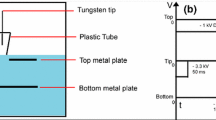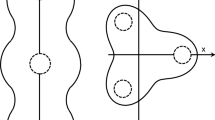Abstract
A recent proposal by Maris,1 that single electron bubbles in helium might fission into separate, particle-like entities, does not properly take into account the failure of the adiabatic approximation when, due to tunneling, there is a long electronic time scale. The point along the fission pathway of a photoexcited p-state bubble, where the adiabatic approximation first breaks down, occurs well before the bubble waist has pinched down forming two cavities. In the connected two-lobed geometry, the p- and s-states are strongly mixed by an antisymmetric vibrational mode, and the excitation decays by the mechanism where one lobe collapses while the other expands into the spherical s-state geometry. The extreme pressure jump in a photoexcited bubble leads to shock formation that may halt the elongation even before adiabaticity is compromised. In this case, the photoexcited bubble decays radiatively from the relaxed p-state geometry.
Similar content being viewed by others
REFERENCES
H. J. Maris, On the fission of elementary particles and the evidence for fractional electrons in liquid helium, J. Low Temp. Phys. 120, 173 (2000).
V. Elser, unpublished.
B. Space and D. F. Coker, Nonadiabatic dynamics of excited excess electrons in simple fluids, J. Chem. Phys. 94, 1976–1984 (1991).
C.-D. Ohl, A. Philipp, and W. Lauterborn, Cavitation bubble collapse studied at 20 million frames per second, Ann. Physik 4, 26–34 (1995).
F. R. Hope, M. J. Baird, and A. F. G. Wyatt, Quantum evaporation from liquid 4He by rotons, Phys. Rev. Lett. 52, 1528–1531 (1984).
C. C. Grimes and G. Adams, Infrared spectrum of the electron bubble in liquid helium, Phys. Rev. B 41, 6366–6371 (1990).
J. D. Jackson, Classical Electrodynamics, 3rd ed. (John Wiley & Sons Inc., New York, 1999).
P. H. Roberts, R. W. Walden, and R. J. Donnelly, Bound states of rotons to impurities in He II, J. Low Temp. Phys. 31, 389–408 (1978).
R. Jackiw, C. Rebbi, and J. R. Schrieffer, Fractional electrons in liquid helium?, to appear in J. Low. Temp. Phys. (2001).
Author information
Authors and Affiliations
Additional information
An erratum to this article is available at http://dx.doi.org/10.1007/s10909-015-1291-0.
Rights and permissions
About this article
Cite this article
Elser, V. Indivisibility of Electron Bubbles in Helium. Journal of Low Temperature Physics 123, 7–23 (2001). https://doi.org/10.1023/A:1017534129860
Issue Date:
DOI: https://doi.org/10.1023/A:1017534129860




